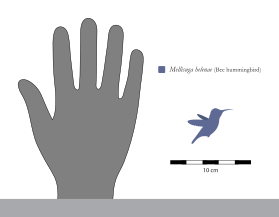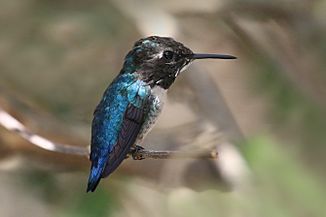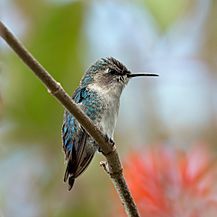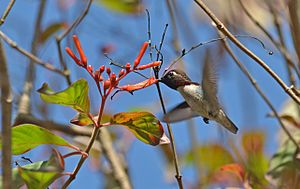Bee hummingbird facts for kids
Quick facts for kids Bee hummingbird |
|
|---|---|
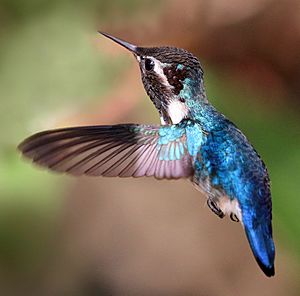 |
|
| Male in flight | |
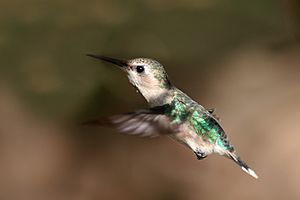 |
|
| Female in flight | |
| Conservation status | |
| Scientific classification | |
| Genus: |
Mellisuga
|
| Species: |
helenae
|
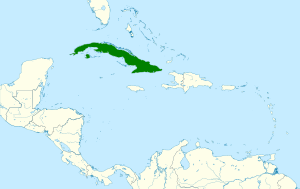 |
|
The bee hummingbird, also known as the zunzuncito or Helena hummingbird (scientific name: Mellisuga helenae), is a tiny hummingbird that lives on the island of Cuba in the Caribbean Sea. It is the smallest bird in the world!
This amazing bird is also the smallest known dinosaur. No smaller bird or non-avian (non-bird) dinosaur has ever been found in the fossil record.
Contents
Discover the Bee Hummingbird
The bee hummingbird is the smallest living bird on Earth. Female bee hummingbirds are a bit larger than males. Females weigh about 2.6 grams (0.09 ounces) and are 6.1 centimeters (2.4 inches) long. Males weigh around 1.95 grams (0.069 ounces) and are 5.5 centimeters (2.2 inches) long. Like all hummingbirds, they are very fast and strong flyers.
What Does a Bee Hummingbird Look Like?
Male bee hummingbirds have a green cap on their head (called a pileum). Their throat is a bright, shiny red, with special long feathers that look like a fancy collar (a gorget). Their upper body is bluish, and their belly is mostly grayish-white. Compared to other small hummingbirds, the bee hummingbird looks round and plump.
Female bee hummingbirds are bluish-green on top and pale gray underneath. The tips of their tail feathers have small white spots. During the mating season, males show off their reddish to pink head, chin, and throat.
Amazing Feathers and Feeding Habits
The bee hummingbird's feathers have iridescent colors. This means they shimmer and change color depending on how the light hits them. It's like a tiny rainbow!
The bird has a thin, pointed bill that is perfect for reaching deep inside flowers. Bee hummingbirds mostly eat nectar, which is a sweet liquid found in flowers. They use their tongue to quickly slurp the nectar.
While they are feeding, pollen from the flower sticks to their bill and head. When they fly to another flower, they carry this pollen with them. This helps the plants make seeds, which is called plant reproduction. A bee hummingbird can visit up to 1,500 flowers in just one day!
Speed and Lifespan
Bee hummingbirds are active during the day (they are diurnal birds). They can fly very fast, between 40 and 48 kilometers per hour (25–30 miles per hour). Their wings beat incredibly fast, from 80 to 200 times per second! This super-fast wing beat allows them to hover perfectly still in the air while they drink nectar from flowers.
In the wild, a bee hummingbird can live for up to seven years. If they are cared for by humans, they can live even longer, sometimes up to 10 years.
-
Adult male bee hummingbird in Cuba
What Do Bee Hummingbirds Eat?
Bee hummingbirds visit many different types of flowers to find nectar. They have been seen feeding from at least ten plant species. Most of these plants are native to Cuba. Some of the flowers they visit include Hamelia patens, Chrysobalanus icaco, and Lysiloma latisiliquum.
Sometimes, they also eat small insects and spiders. To get enough energy, bee hummingbirds can eat up to half of their own body weight in food every single day!
Where Do Bee Hummingbirds Live?
The bee hummingbird is endemic to the Cuban archipelago. This means it lives only in Cuba and its surrounding islands, like the Isla de la Juventud in the West Indies.
Their population is spread out in different areas. You can find them in the mogote areas of Pinar del Rio province and more often in the Zapata Swamp (Matanzas province). They also live in eastern Cuba, in places like Alexander Humboldt National Park and Baitiquirí Ecological Reserve.
How Do Bee Hummingbirds Have Babies?
Male bee hummingbirds try to attract females by making sounds with their tail feathers. These feathers flutter quickly when the male performs special display dives. The breeding season for bee hummingbirds is from March to June. During this time, the female will lay one or two tiny eggs.
Building a Tiny Nest
Female bee hummingbirds are amazing builders! They create a small, cup-shaped nest, about 2.5 centimeters (1 inch) across. They use materials like strands of cobwebs, pieces of bark, and lichen. They line the inside of the nest with soft plant fibers to make it cozy.
They often build their nests on branches of mature Jucaro trees (Bucida buceras) or young Ocuje trees (Calophyllum antillanum).
Raising the Chicks
After the nest is finished, the female hummingbird sits on the eggs to keep them warm. This is called incubation, and it lasts for 21 days. Only the mother bird takes care of the eggs.
After the eggs hatch, the mother bird continues to care for the chicks for about 18 days. In the last 4 to 5 days before they leave the nest (called fledging), the young bee hummingbirds practice flying. Bee hummingbird nests are only used once. After the babies leave, the nests break down naturally from rain and other weather.
Working Together with Flowers
The way bee hummingbirds interact with the flowers they feed from is a great example of coevolution. This means that the birds and the flowers have changed and developed together over a long time. The flowers provide nectar for the birds, and the birds help the flowers reproduce by spreading pollen. It's a perfect partnership!
See also
 In Spanish: Zunzuncito para niños
In Spanish: Zunzuncito para niños



